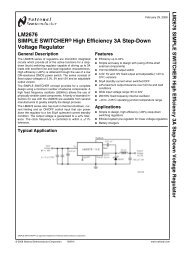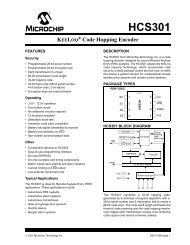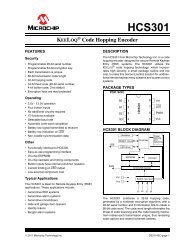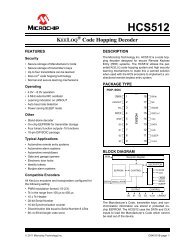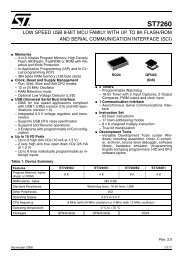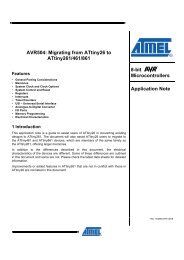dsPIC30F2010 Data Sheet - Microchip
dsPIC30F2010 Data Sheet - Microchip
dsPIC30F2010 Data Sheet - Microchip
Create successful ePaper yourself
Turn your PDF publications into a flip-book with our unique Google optimized e-Paper software.
<strong>dsPIC30F2010</strong><br />
2.4.1 MULTIPLIER<br />
The 17 x 17-bit multiplier is capable of signed or<br />
unsigned operation and can multiplex its output<br />
using a scaler to support either 1.31 fractional (Q31)<br />
or 32-bit integer results. Unsigned operands are<br />
zero-extended into the 17th bit of the multiplier input<br />
value. Signed operands are sign-extended into the<br />
17th bit of the multiplier input value. The output of<br />
the 17 x 17-bit multiplier/scaler is a 33-bit value,<br />
which is sign-extended to 40 bits. Integer data is<br />
inherently represented as a signed two’s complement<br />
value, where the MSB is defined as a sign bit.<br />
Generally speaking, the range of an N-bit two’s<br />
complement integer is -2 N-1 to 2 N-1 – 1. For a 16-bit<br />
integer, the data range is -32768 (0x8000) to 32767<br />
(0x7FFF), including ‘0’. For a 32-bit integer, the data<br />
range is -2,147,483,648 (0x8000 0000) to<br />
2,147,483,645 (0x7FFF FFFF).<br />
When the multiplier is configured for fractional<br />
multiplication, the data is represented as a two’s<br />
complement fraction, where the MSB is defined as a<br />
sign bit and the radix point is implied to lie just after the<br />
sign bit (QX format). The range of an N-bit two’s<br />
complement fraction with this implied radix point is -1.0<br />
to (1-2 1-N ). For a 16-bit fraction, the Q15 data range is<br />
-1.0 (0x8000) to 0.999969482 (0x7FFF), including ‘0’<br />
and has a precision of 3.01518x10 -5 . In Fractional<br />
mode, a 16x16 multiply operation generates a 1.31<br />
product, which has a precision of 4.65661x10 -10 .<br />
The same multiplier is used to support the MCU multiply<br />
instructions, which include integer 16-bit signed,<br />
unsigned and mixed sign multiplies.<br />
The MUL instruction may be directed to use byte or<br />
word-sized operands. Byte operands will direct a 16-bit<br />
result, and word operands will direct a 32-bit result to<br />
the specified register(s) in the W array.<br />
2.4.2 DATA ACCUMULATORS AND<br />
ADDER/SUBTRACTER<br />
The data accumulator consists of a 40-bit adder/<br />
subtracter with automatic sign extension logic. It can<br />
select one of two accumulators (A or B) as its preaccumulation<br />
source and post-accumulation<br />
destination. For the ADD and LAC instructions, the data<br />
to be accumulated or loaded can be optionally scaled<br />
via the barrel shifter, prior to accumulation.<br />
2.4.2.1 Adder/Subtracter, Overflow and<br />
Saturation<br />
The adder/subtracter is a 40-bit adder with an optional<br />
zero input into one side and either true or complement<br />
data into the other input. In the case of addition, the<br />
carry/borrow input is active high and the other input is<br />
true data (not complemented), whereas in the case of<br />
subtraction, the carry/borrow input is active low and the<br />
other input is complemented. The adder/subtracter<br />
generates overflow status bits SA/SB and OA/OB,<br />
which are latched and reflected in the STATUS<br />
Register.<br />
• Overflow from bit 39: this is a catastrophic<br />
overflow in which the sign of the accumulator is<br />
destroyed.<br />
• Overflow into guard bits 32 through 39: this is a<br />
recoverable overflow. This bit is set whenever all<br />
the guard bits are not identical to each other.<br />
The adder has an additional saturation block which<br />
controls accumulator data saturation, if selected. It<br />
uses the result of the adder, the overflow status bits<br />
described above, and the SATA/B (CORCON)<br />
and ACCSAT (CORCON) mode control bits to<br />
determine when and to what value to saturate.<br />
Six STATUS register bits have been provided to<br />
support saturation and overflow; they are:<br />
1. OA:<br />
ACCA overflowed into guard bits<br />
2. OB:<br />
ACCB overflowed into guard bits<br />
3. SA:<br />
ACCA saturated (bit 31 overflow and saturation)<br />
or<br />
ACCA overflowed into guard bits and saturated<br />
(bit 39 overflow and saturation)<br />
4. SB:<br />
ACCB saturated (bit 31 overflow and saturation)<br />
or<br />
ACCB overflowed into guard bits and saturated<br />
(bit 39 overflow and saturation)<br />
5. OAB:<br />
Logical OR of OA and OB<br />
6. SAB:<br />
Logical OR of SA and SB<br />
The OA and OB bits are modified each time data<br />
passes through the adder/subtracter. When set, they<br />
indicate that the most recent operation has overflowed<br />
into the accumulator guard bits (bits 32 through 39).<br />
The OA and OB bits can also optionally generate an<br />
arithmetic warning trap when set and the corresponding<br />
overflow trap flag enable bit (OVATE, OVBTE) in<br />
the INTCON1 register (refer to Section 5.0 “Interrupts”)<br />
is set. This allows the user to take immediate<br />
action, for example, to correct system gain.<br />
DS70118J-page 16<br />
© 2011 <strong>Microchip</strong> Technology Inc.





